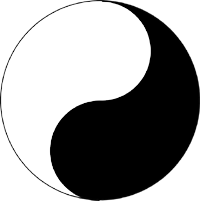
Opposites are common: white and black, summer and winter, day and night, new and old, above and below, and so on. And it is easy to see that there is a half-way point that is neither quite one nor the other: grey, spring (or autumn), dawn (or dusk), middle age, the middle ground.
The Daoists, like many Oriental philosophers were intrigued by the idea of the middle way, and instinctively distrusted extremes. Even peace, if pursued as an end in itself, could lead to inactivity, lethargy and decay, resulting in death just as surely as war (and that's if the peace movement hadn't already become intolerant, fanatical and militant and, thereby, self-defeating).
An ultra thin line separates the yang from the yin on the Taiji Tu. Arguably, the width of this line is no greater than that of the momentary present separating the past from the future. Yet it is on the cusp of this line that we experience life. The interactions of opposites produce the infinite complexity of the universe.

Originally, the words yang and yin meant sunny and shady respectively, and were used to describe the sides of a hill. It is important to note that they refer to two sides of the same thing: the philosophy of yang and yin is not dualistic, but holistic.
In the gua, yang is depicted as a line.

This is characterised by uniformity: the line is the same throughout, which portrays the sun shining on all equally. It may also be visualised as a shaft or ray of sunlight.
In the gua, yin is depicted as a broken line.

This is characterised by a space, a gap, a hole, emptiness, etc. This can be visualised as the shadow of a hill interrupting the surrounding sunlight .
We can now use these lines to symbolise any of the pairs of opposites introduced above. Crucially for feng shui, the list of opposites can now also accommodate ideas of direction (the sunny side of the hill is the southern side, and the shady side is the northern).
We can even use them to denote, respectively, something and nothing (sunlight, and its absence), which is a sort of binary coding: 1, and 0. In electronics, digital devices such as processor chips use the binary code of 1=electricity working, and 0=electricity not working.
This notion of a binary code is a vital key to unlocking many of the mysteries of the Early Heaven gua (place value is denoted by the layers).
There are two ways of reading this binary code: from the top down, and from the bottom up.
The top down method gives the top layer the place value of 1, the middle layer has the place value of 2, and the bottom layer has the place value of 4. For example the gua Dui (Lake) can be read as follows:


The bottom up method gives the bottom layer the place value of 1, the middle layer 2, and the top layer 4. For example, again the gua Dui (Lake) can be read as follows:


These numbers can be arranged around the Early Heaven ba gua.
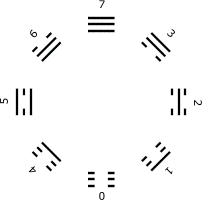
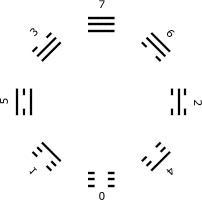
Tracing a line from each number to the next in sequence draws two remarkable glyphs.
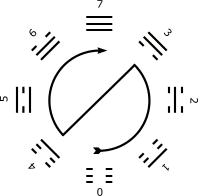
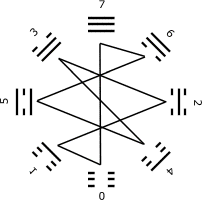
These are crucial to our understanding of, respectively, the Taiji Tu, and the Luo Shu.
Incidentally, the mathematician G W Leibniz (1646-1716), renowned as the founding father of binary in the West, recognised the gua as a form of binary notation. But it would still surprise many Western mathematicians that, if the gua are as old as tradition maintains, the ancient Chinese had also invented a way of writing the numeral zero.
© Ken Taylor 2004-2006